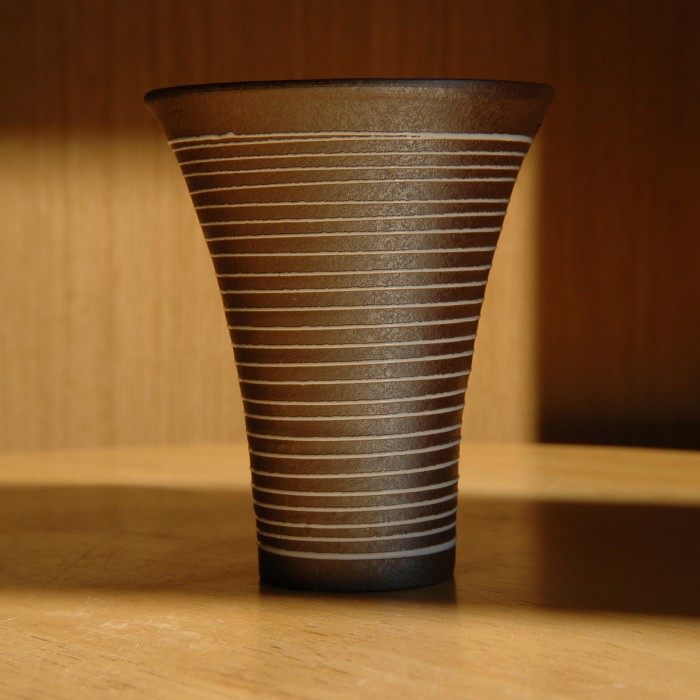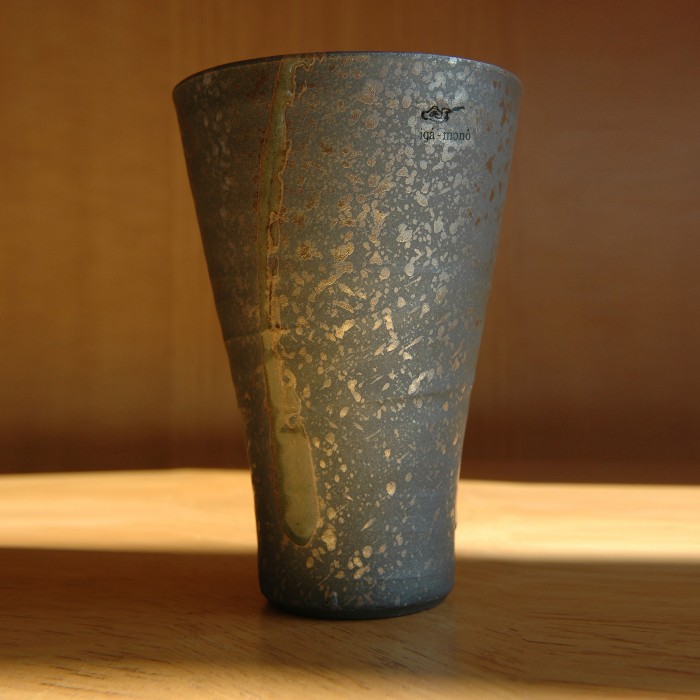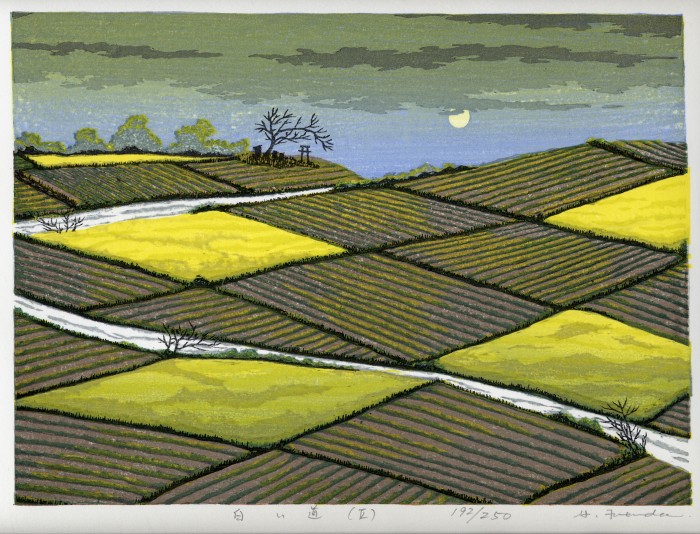Archive for the ‘Uncategorized’ Category
Monday, March 29th, 2010
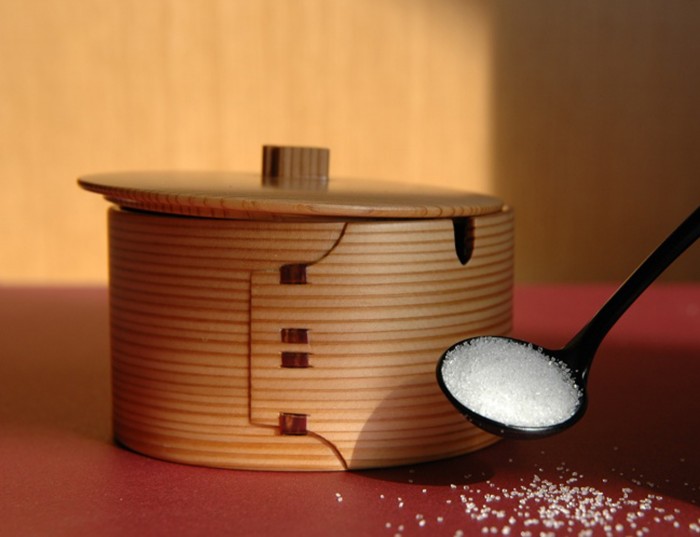
This charming sugar bowl makes for a happy little addition to the home. Stores sugar or, should you wish, spices, herbs, etc. Set comes with a plastic spoon that fits neatly under the lid. The gorgeous cedar wood is fastened together with carefully chosen slices of sakura (Japanese cherry blossom) bark. You’ll absolutely love this artistic and practical piece.
Product details
- completely hand-crafted from Akita located in northern Japan
- diameter: 9.5cm (3.7″) ; height: 6.5cm (2.5″)
- lightweight, yet remarkably strong – made to last for years.
- hand-wash with warm water and soap and store in a dry cool place
- Price is for a set of 10. Wholesale price!
- do not microwave
Magewappa is a marvelous 400-year old traditional craft that originated in Odate City in Japan’s northern Akita prefecture. It is painstakingly created by thinly shaving perfectly straight-grain cedar wood, specially planted on the eastern side of the Shirakami Mountains, a present-day World Heritage Natural Resource site. This complex procedure involves boiling the shavings, and repeatedly bending and fastening them together by hand with carefully chosen slices of sakura (Japanese cherry blossom) bark. Only cedar wood that is 100 years old or more can endure this demanding process.
A finished Magewappa creation is remarkably lightweight and bears a naturally faint aroma that magnificently compliments Japanese food and drink – especially sushi and sake. Sushi-bachi plates are further treated with a gorgeous red lacquer to aid preservation and presentation. A true feast for the eyes and a sure conversation-starter when entertaining friends and guests.
Posted in Uncategorized | No Comments »
Monday, March 29th, 2010
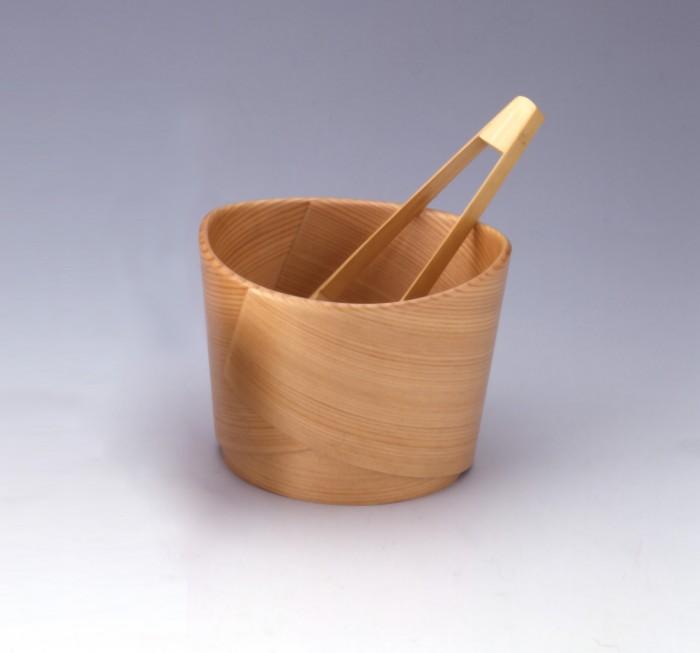
This attractive, award-winning* ice pail is eye-catching and makes a fun and enjoyable addition to the home. Ice stays cool for long periods of time thanks to the northern Japanese cedar wood and the pail’s elegant design. The set comes with handsome tongs – also handcrafted from century-old cedar wood.
Product details
- this product was given the prestigious “GOOD DESIGN” award for excellence in design and craftsmanship. (www.g-mark.org)
- completely hand-crafted from Akita located in northern Japan
- diameter: 15.2cm (6″) ; height: 12cm (2.3″)
- lightweight, yet remarkably strong – made to last for years.
- hand-wash with warm water and soap and store in a dry cool place
- set includes ice pail and tongs
- do not microwave
Magewappa is a marvelous 400-year old traditional craft that originated in Odate City in Japan’s northern Akita prefecture. It is painstakingly created by thinly shaving perfectly straight-grain cedar wood, specially planted on the eastern side of the Shirakami Mountains, a present-day World Heritage Natural Resource site. This complex procedure involves boiling the shavings, and repeatedly bending and fastening them together by hand with carefully chosen slices of sakura (Japanese cherry blossom) bark. Only cedar wood that is 100 years old or more can endure this demanding process.
A finished Magewappa creation is remarkably lightweight and bears a naturally faint aroma that magnificently compliments Japanese food and drink – especially sushi and sake. Sushi-bachi plates are further treated with a gorgeous red lacquer to aid preservation and presentation. A true feast for the eyes and a sure conversation-starter when entertaining friends and guests.
Posted in Uncategorized | No Comments »
Monday, March 29th, 2010
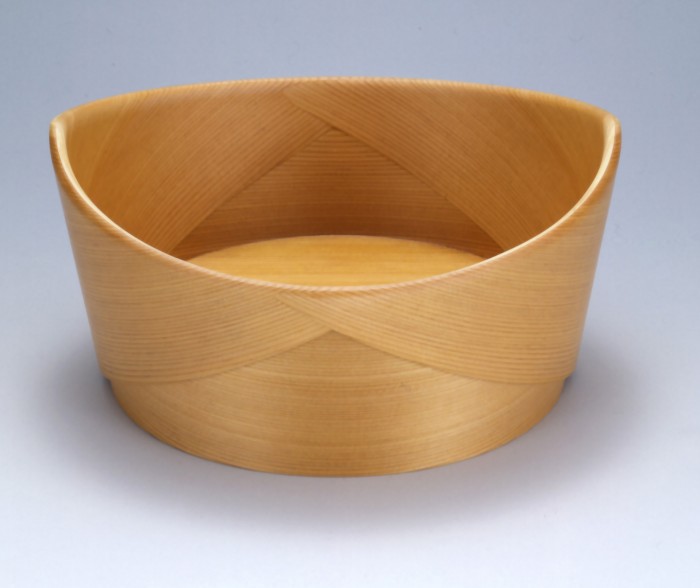
This striking, award-winning* fruit bowl is the first of its kind in the world. Absolutely original, this bowl’s inspired cylindrical design allows multiple fruit bowls to be stacked on top of each other for easy and tidy storage. Notice how the slices of cedar wood overlay one another, reminiscent of the shape of a kimono. This piece is simultaneously artistic and practical, sure to capture the attention (and envy!) of friends and family.
Product details
- *awarded the prestigious “GOOD DESIGN” prize for excellence in design and craftsmanship
- completely hand-crafted in Akita, located in northern Japan
- diameter: 24.5cm (9.6″) ; height: 12cm (2.3″)
- lightweight, yet remarkably strong – made to last for years.
- hand-wash with warm water and soap and store in a dry cool place Odate City
- do not microwave
Magewappa is a marvelous 400-year old traditional craft that originated in Odate City in Japan’s northern Akita prefecture. It is painstakingly created by thinly shaving perfectly straight-grain cedar wood, specially planted on the eastern side of the Shirakami Mountains, a present-day World Heritage Natural Resource site. This complex procedure involves boiling the shavings, and repeatedly bending and fastening them together by hand with carefully chosen slices of sakura (Japanese cherry blossom) bark. Only cedar wood that is 100 years old or more can endure this demanding process.
A finished Magewappa creation is remarkably lightweight and bears a naturally faint aroma that magnificently compliments Japanese food and drink – especially sushi and sake. Sushi-bachi plates are further treated with a gorgeous red lacquer to aid preservation and presentation. A true feast for the eyes and a sure conversation-starter when entertaining friends and guests.
Posted in Uncategorized | No Comments »
Monday, March 29th, 2010
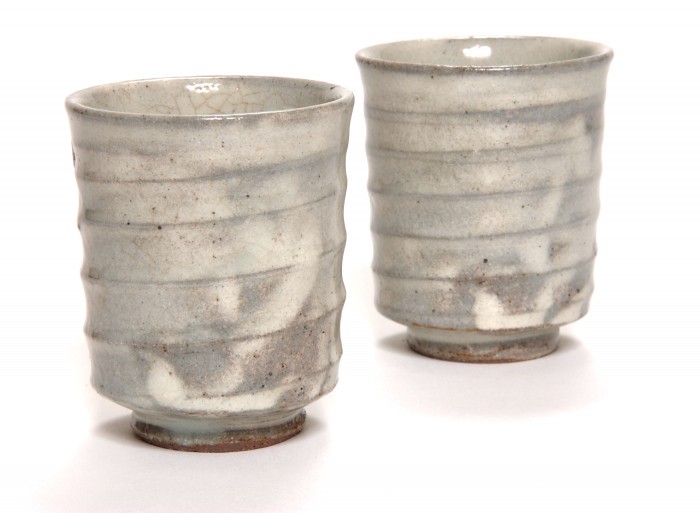
Relax and unwind with genuine Japanese tea cups from Iga city – this is truly the real Japanese tea drinking experience. Made using a special Kobiki creation process, the cups have a distinctive whitish-red colour, due in part to the red clay lies on the bottom of Lake Biwa – Japan’s largest freshwater lake, located just north of the traditional capital city of Kyoto.Iga pottery is handmade and formed at extremely high temperatures to deliver a rough yet elegant textured finish. The results are truly remarkable. Why not consider an authentic Tetsubin (cast-iron teapot) that goes so perfectly with this product? You can order one at the bottom of this page.
- Completely handmade from the famous Iga region of Japan
- Unique Kobiki creation process
- Can use for any occasion, formal or casual
- Authentic, beautiful and original
- Two tea cups are included in the set
A little ninja history
The Iga region is considered by many to be the birthplace of the ninja. The Iga ninja were skilled in the fine art of stealth, known particularly as expert castle infiltrators who could obtain secret information and sabotage enemy supplies. These talents were passed on from father to son and, for generations, warring daimyo knew that the best ninja in Japan could be hired in Iga.
Posted in Uncategorized | No Comments »
Monday, March 29th, 2010
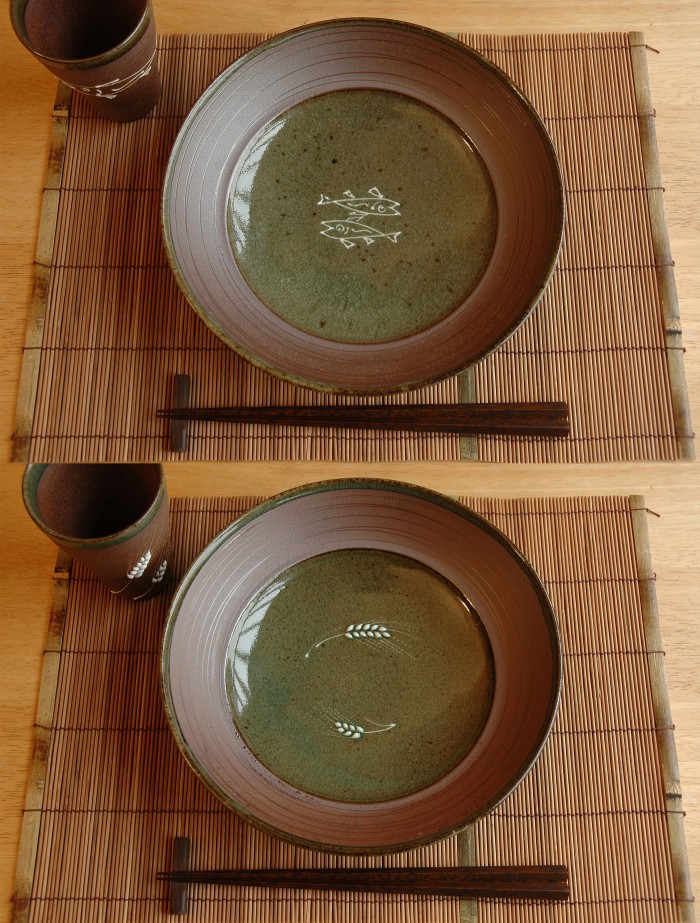
The plates in this distinctive set boast an attractive combination of complimentary textures. The plates’ outer section is lined with Iga’s trademark rough earthenware feel while the centre serving area features a smooth glaze.
The handsome barley and fish patterns are traditional motifs of the region and maker. The fish are reminiscent of the zodiac’s “Pisces”, but carry no formal connection. Your gift dilemmas are solved: this set is just as enjoyable to give as to receive.
- Completely handmade from the famous Iga region of Japan
- Plate size: 23cm (9″) diameter, 5.5cm (2.1″) tall
- Hand painted motifs of the barley and fish, using special glazing technique
- Glazed along the rim and bottom of the plate
- Microwave safe
- Can use for any occasion, formal or casual
- Authentic, beautiful and original. Makes for an excellent gift.
A little ninja history
The Iga region is considered by many to be the birthplace of the ninja. The Iga ninja were skilled in the fine art of stealth, known particularly as expert castle infiltrators who could obtain secret information and sabotage enemy supplies. These talents were passed on from father to son and, for generations, warring daimyo knew that the best ninja in Japan could be hired in Iga.
There is a secret beauty in the simplicity of pottery from Iga (Igamono), a city founded some 1,200 years ago. Iga pottery is made from the special clay that lies on the bottom of Lake Biwa – Japan’s largest freshwater lake, located just north of the traditional capital city of Kyoto.
Iga pottery is handmade and formed at extremely high temperatures to deliver a rough yet elegant textured finish. The results are truly fantastic.
Posted in Uncategorized | No Comments »
Monday, March 29th, 2010
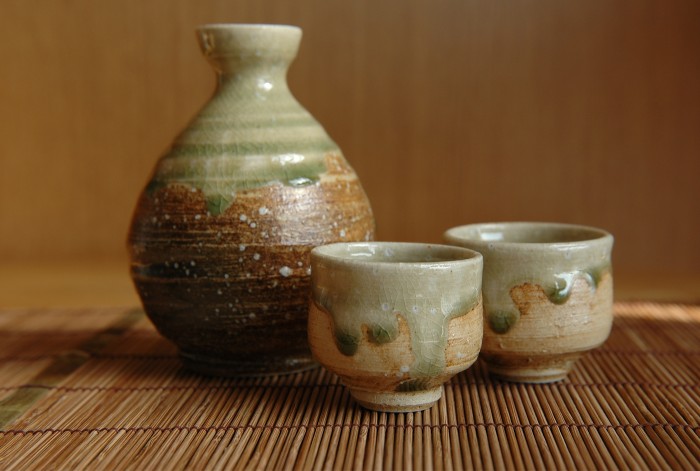
There is a secret beauty in the simplicity of pottery from Iga (Igamono), a city founded some 1,200 years ago. Iga pottery is made from the special clay that lies on the bottom of Lake Biwa – Japan’s largest freshwater lake, located just north of the traditional capital city of Kyoto.Iga pottery is handmade and formed at extremely high temperatures to deliver a rough yet elegant textured finish. The results are truly fantastic.
The colours of this lovely handmade sake pot and 2-cup set are a work of art. This is a product for those who want a truly authentic sake experience, to fully appreciate the traditional “rice wine” of Japan. The deep earth-green glazed look is emblematic of the distinctive process that makes Iga pottery so unique.
- Completely handmade from the famous Iga region of Japan
- Pot size: 9cm(3.5″) tall, holds about 230ml
- Cups: 3cm (1.5″) tall, holds up to 70ml
- Cups have a distinctively rough texture
- Microwave safe
- Can use to hold tea and other liquids if desired
- Do not place acidic drinks in the flask or pot
- Authentic, beautiful and original. Makes for a superb gift to a couple or any sake or tea connoisseur.
A little ninja history
The Iga region is considered by many to be the birthplace of the ninja. The Iga ninja were skilled in the fine art of stealth, known particularly as expert castle infiltrators who could obtain secret information and sabotage enemy supplies. These talents were passed on from father to son and, for generations, warring daimyo knew that the best ninja in Japan could be hired in Iga.
Posted in Uncategorized | No Comments »
Monday, March 29th, 2010
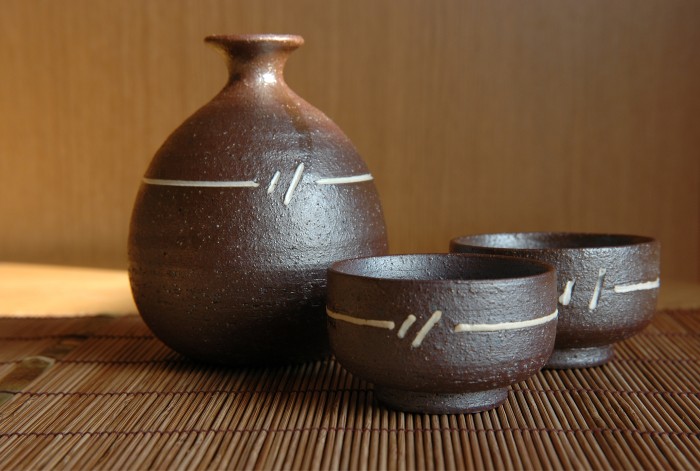
The Warrior Sake Set exudes magnificence. This is a product for those who want a truly authentic sake experience, to fully appreciate the traditional “rice wine” of Japan. The sake pot and 2 cups are handmade and their rich, dark earthen look are characteristic of the Iga region.
- Completely handmade from the famous Iga region of Japan
- Pot size: 11cm(4.3″) tall, holds about 250ml
- Cups: 4cm (1.5″) tall, holds up to 90ml
- Cups are wide, sturdy and have a naturally rough texture
- Microwave safe
- Can use to hold tea and other liquids if desired
- Do not place acidic drinks in the flask or pot
- Authentic, beautiful and original. Makes for a superb gift to a couple or any sake or tea connoisseur.
A little ninja history
The Iga region is considered by many to be the birthplace of the ninja. The Iga ninja were skilled in the fine art of stealth, known particularly as expert castle infiltrators who could obtain secret information and sabotage enemy supplies. These talents were passed on from father to son and, for generations, warring daimyo knew that the best ninja in Japan could be hired in Iga.
There is a secret beauty in the simplicity of pottery from Iga (Igamono), a city founded some 1,200 years ago. Iga pottery is made from the special clay that lies on the bottom of Lake Biwa – Japan’s largest freshwater lake, located just north of the traditional capital city of Kyoto.
Iga pottery is handmade and formed at extremely high temperatures to deliver a rough yet elegant textured finish. The results are truly fantastic.
Posted in Uncategorized | No Comments »
Monday, March 29th, 2010
Beer Lovers Rejoice!
The Empress Igamono Beer Mug features a fine winding horizontal line that forms a gentle grip on the mug. It’s classy, regal and so distinctive. Igamono beer mugs are superbly designed originals that also makes beer taste even better. Here’s why:
- Smooth, delicious foam. The slightly rough surface allows the beer to pour effortlessly, helping to form a smooth cloud of foam.
- Keeps the beer cool. Best to rinse the mug with cold water, and leave beer mug in the fridge for 30 minutes (it’s well worth the wait) before pouring the beer into the mug. The material composition acts like an insulator, retaining the cold longer than a regular glass.
- Comfortable to hold, looks great. Fits perfectly in hand, essentially a non-slip surface and it looks superb.
Take our word for it, anyone will love and appreciate this gift over and over again. Try it with your favorite micro-brew.
A Little Ninja History
Iga pottery is handmade and formed at extremely high temperatures to deliver a rough yet elegant textured finish. The results are truly fantastic.
The Iga region is considered by many to be the birthplace of the ninja. The Iga ninja were skilled in the fine art of stealth, known particularly as expert castle infiltrators who could obtain secret information and sabotage enemy supplies. These talents were passed on from father to son and, for generations, warring daimyo knew that the best ninja in Japan could be hired in Iga.
There is a secret beauty in the simplicity of pottery from Iga (Igamono), a city founded some 1,200 years ago. Iga pottery is made from the special clay that lies on the bottom of Lake Biwa – Japan’s largest freshwater lake, located just north of the traditional capital city of Kyoto.
Price Includes
- Each quantity unit purchased will come with 2 Empress Igamono Beer Mugs handcrafted in Mie prefecture, Japan. Therefore if you decide to place an order quantity of 3, you will receive a total of 6 beer mugs.
- Each mug is individually packaged in it’s own box that has printed Japanese calligraphy on cover (very beautiful)
- A thoughtful gift for any occasion
- Comprehensive product description (text that appears on this page without price)
Buy With Confidence
- 110% Money Back Guarantee
- Payments: Fully Secure through PayPal (accepting all major credit cards and debit cards). Not to worry, you don’t need a PayPal account to complete the transaction – it’s very straightforward.
- Domestic Delivery: Free Delivery within Japan, which includes US Military Bases (APO and FPO)
- International Delivery: Just $19.99 per set of 2 mugs. Shipment sent via EMS (Express Mail Service), that’s complete with tracking code. Shipment normally arrives within 4 days once it leaves Japan.
- Authenticity: Guaranteed. A product purchased from Unique Japan is a genuine Japanese master craftsmanship creation.
Posted in Uncategorized | No Comments »
Monday, March 29th, 2010
Beer lovers rejoice! The Large Brushed Stone Igamono Beer Mug is one of Unique Japan’s most popular items, and for very good reason. Its attractive freckled surface and distinctive brushed glaze finish not only make it a superbly designed original, but also makes beer taste even better. Here’s why…
- Smooth, delicious foam. The slightly rough surface allows the beer to pour effortlessly, helping to form a smooth cloud of foam.
- Keeps the beer cool. Best to leave beer mug in the fridge for 30 minutes (it’s well worth the wait) before pouring the beer into the mug. The material composition acts like an insulator, retaining the cold longer than a regular glass.
- Comfortable to hold, looks great. Fits perfectly in hand, essentially a non-slip surface and it looks superb. Diameter (top) 10cm (4″), Height 14.5cm (5.75”)
Take our word for it, any guy will love and appreciate this gift over and over again. Try it with your favorite micro-brew.
A little ninja history
Iga pottery is handmade and formed at extremely high temperatures to deliver a rough yet elegant textured finish. The results are truly fantastic.
The Iga region is considered by many to be the birthplace of the ninja. The Iga ninja were skilled in the fine art of stealth, known particularly as expert castle infiltrators who could obtain secret information and sabotage enemy supplies. These talents were passed on from father to son and, for generations, warring daimyo knew that the best ninja in Japan could be hired in Iga.
There is a secret beauty in the simplicity of pottery from Iga (Igamono), a city founded some 1,200 years ago. Iga pottery is made from the special clay that lies on the bottom of Lake Biwa – Japan’s largest freshwater lake, located just north of the traditional capital city of Kyoto.
Posted in Uncategorized | No Comments »
Monday, March 29th, 2010
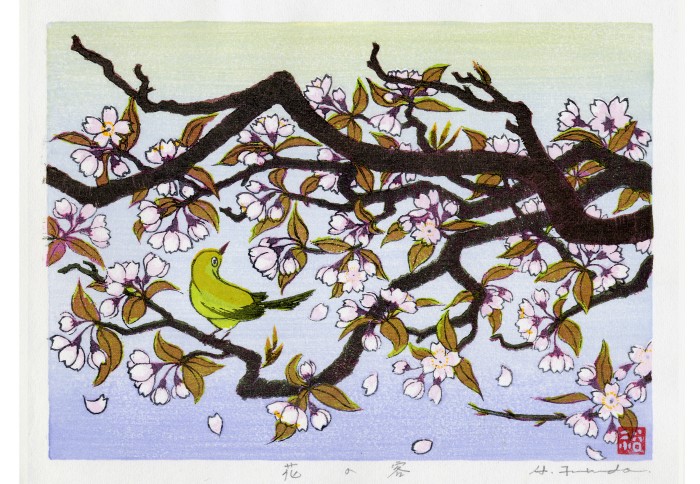
Usher in spring with this beautiful woodblock print by the renowned Hirokazu Fukuda (1944-2004). Delightfully decorated with an abundance of blooming sakuras, Hanakyaku (“Admiring the Sakura Blossom”) brightens moods with all the promise of a new season. Hand-carved and hand-painted, each print is individually stamped and signed by the artist. Limited quantity remaining.Japanese woodblock printing carries a long, rich history that reached its heights in the Edo period (1603 to 1867). Traditionally the art of creating a woodblock print was broken down into the following specialties*:
- First, an artist would create a design.
- From that drawing, a block copyist would create a very fine black-and-white drawing on paper.
- The print would be passed on to blockcarvers who, using chisels, would carve a series of woodblocks—first, a “key block” showing the outlines of the print, and then one block for each color to be printed – often 15 or more blocks were required.
- When the blocks were complete, printers would apply ink using brushes. Laying a sheet of paper face down on top of the block, the printer rubbed the ink onto [handmade] paper using a round, flat pad, called a “baren”.
Mr. Fukuda applied these very same techniques, with one great exception – all work was designed, hand-carved and, with the help of professionals, hand printed by the artist himself.
Print details:
- Hand-carved and hand printed from 12-15 blocks of wood
- Printed on beautiful hand-made torinokoshi paper
- Individually stamped and signed by the artist
- Limited edition first printing, with only 250 prints made
- 21cm x 19cm (8.2″ x 7.4″)
- Recommended mat border colour: white with a 2-3mm thickness.
Artist profile
Hirokazu Fukuda (1944-2004) was born and raised in the Tochigi prefecture, an area situated a little over an hour north of Tokyo. A picturesque setting, Tochigi is surrounded by mountains and hills to the east, west and north while the Kanto Plains lie to the south. It is also famous for its ancient Shinto shrines and Buddhist temples.
Hirokazu (whose real name is Hiroshi), planned to become a professional classic guitarist but suffered a hand injury at a young age. Hungering after a medium to express his creativity, he first worked with the canvas, then moved on to become a master woodblock artist.
The passing of time never really concerned Mr. Fukuda, a character trait much admired by his peers. His art collection is wonderfully expressive, very true, and seems to bask in the admiration of daily life. According to family and friends, he had always hoped that his work could “touch the heart” of those around him. Mr. Fukuda died peacefully in Tokyo in 2004.
*source: pbs.org
Posted in Uncategorized | No Comments »
Monday, March 29th, 2010
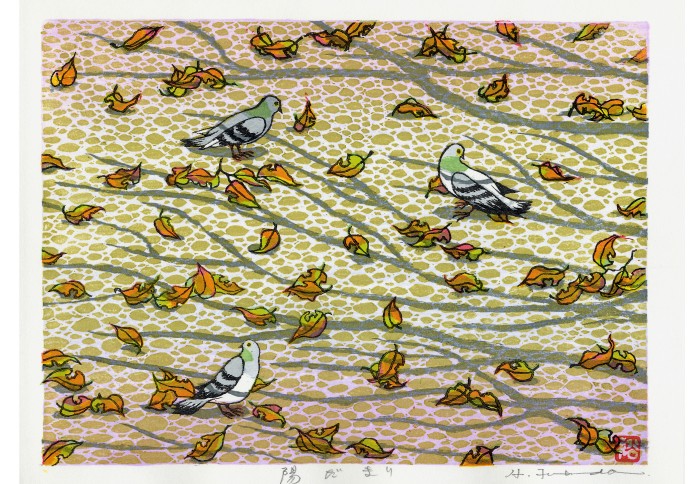
Japanese woodblock printing carries a long, rich history that reached its heights in the Edo period (1603 to 1867). Traditionally the art of creating a woodblock print was broken down into the following specialties*:
- First, an artist would create a design.
- From that drawing, a block copyist would create a very fine black-and-white drawing on paper.
- The print would be passed on to blockcarvers who, using chisels, would carve a series of woodblocks—first, a “key block” showing the outlines of the print, and then one block for each color to be printed – often 15 or more blocks were required.
- When the blocks were complete, printers would apply ink using brushes. Laying a sheet of paper face down on top of the block, the printer rubbed the ink onto [handmade] paper using a round, flat pad, called a “baren”.
Mr. Fukuda applied these very same techniques, with one great exception – all work was designed, hand-carved and, with the help of professionals, hand printed by the artist himself.
Print details:
- Hand-carved and hand printed from 12-15 blocks of wood
- Printed on beautiful hand-made torinokoshi paper
- Individually stamped and signed by the artist
- Limited edition first printing, with only 250 prints made
- 21cm x 19cm (8.2″ x 7.4″)
- Recommended mat border colour: white with a 2-3mm thickness.
Artist profile
Hirokazu Fukuda (1944-2004) was born and raised in the Tochigi prefecture, an area situated a little over an hour north of Tokyo. A picturesque setting, Tochigi is surrounded by mountains and hills to the east, west and north while the Kanto Plains lie to the south. It is also famous for its ancient Shinto shrines and Buddhist temples.
Hirokazu (whose real name is Hiroshi), planned to become a professional classic guitarist but suffered a hand injury at a young age. Hungering after a medium to express his creativity, he first worked with the canvas, then moved on to become a master woodblock artist.
The passing of time never really concerned Mr. Fukuda, a character trait much admired by his peers. His art collection is wonderfully expressive, very true, and seems to bask in the admiration of daily life. According to family and friends, he had always hoped that his work could “touch the heart” of those around him. Mr. Fukuda died peacefully in Tokyo in 2004.
*source: pbs.org
Posted in Uncategorized | No Comments »
Monday, March 29th, 2010
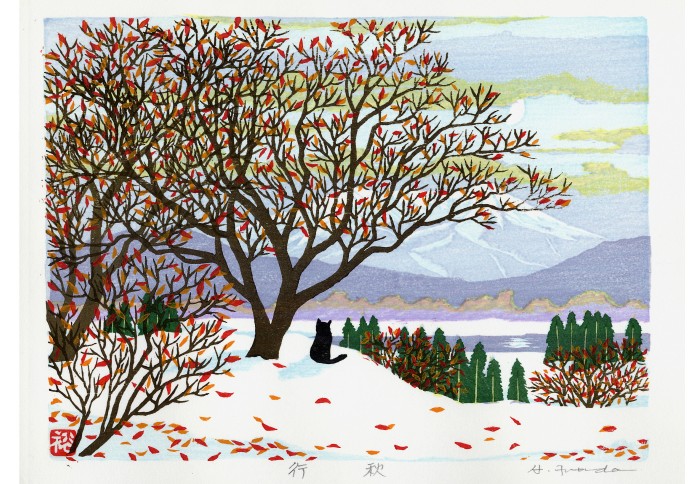
Japanese woodblock printing carries a long, rich history that reached its heights in the Edo period (1603 to 1867). Traditionally the art of creating a woodblock print was broken down into the following specialties*:
- First, an artist would create a design.
- From that drawing, a block copyist would create a very fine black-and-white drawing on paper.
- The print would be passed on to blockcarvers who, using chisels, would carve a series of woodblocks—first, a “key block” showing the outlines of the print, and then one block for each color to be printed – often 15 or more blocks were required.
- When the blocks were complete, printers would apply ink using brushes. Laying a sheet of paper face down on top of the block, the printer rubbed the ink onto [handmade] paper using a round, flat pad, called a “baren”.
Mr. Fukuda applied these very same techniques, with one great exception – all work was designed, hand-carved and, with the help of professionals, hand printed by the artist himself.
Print details:
- Hand-carved and hand printed from 12-15 blocks of wood
- Printed on beautiful hand-made torinokoshi paper
- Individually stamped and signed by the artist
- Limited edition first printing, with only 250 prints made
- 21cm x 19cm (8.2″ x 7.4″)
- Recommended mat border colour: white with a 2-3mm thickness.
Artist profile
Hirokazu Fukuda (1944-2004) was born and raised in the Tochigi prefecture, an area situated a little over an hour north of Tokyo. A picturesque setting, Tochigi is surrounded by mountains and hills to the east, west and north while the Kanto Plains lie to the south. It is also famous for its ancient Shinto shrines and Buddhist temples.
Hirokazu (whose real name is Hiroshi), planned to become a professional classic guitarist but suffered a hand injury at a young age. Hungering after a medium to express his creativity, he first worked with the canvas, then moved on to become a master woodblock artist.
The passing of time never really concerned Mr. Fukuda, a character trait much admired by his peers. His art collection is wonderfully expressive, very true, and seems to bask in the admiration of daily life. According to family and friends, he had always hoped that his work could “touch the heart” of those around him. Mr. Fukuda died peacefully in Tokyo in 2004.
*source: pbs.org
Posted in Uncategorized | No Comments »
Monday, March 29th, 2010
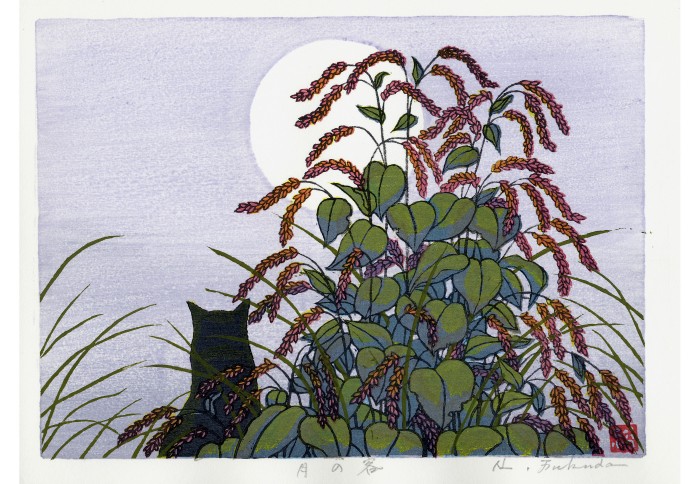
Japanese woodblock printing carries a long, rich history that reached its heights in the Edo period (1603 to 1867). Traditionally the art of creating a woodblock print was broken down into the following specialties*:
- First, an artist would create a design.
- From that drawing, a block copyist would create a very fine black-and-white drawing on paper.
- The print would be passed on to blockcarvers who, using chisels, would carve a series of woodblocks—first, a “key block” showing the outlines of the print, and then one block for each color to be printed – often 15 or more blocks were required.
- When the blocks were complete, printers would apply ink using brushes. Laying a sheet of paper face down on top of the block, the printer rubbed the ink onto [handmade] paper using a round, flat pad, called a “baren”.
Mr. Fukuda applied these very same techniques, with one great exception – all work was designed, hand-carved and, with the help of professionals, hand printed by the artist himself.
Print details:
- Hand-carved and hand printed from 12-15 blocks of wood
- Printed on beautiful hand-made torinokoshi paper
- Individually stamped and signed by the artist
- Limited edition first printing, with only 250 prints made
- 21cm x 19cm (8.2″ x 7.4″)
- Recommended mat border colour: white with a 2-3mm thickness.
Artist profile
Hirokazu Fukuda (1944-2004) was born and raised in the Tochigi prefecture, an area situated a little over an hour north of Tokyo. A picturesque setting, Tochigi is surrounded by mountains and hills to the east, west and north while the Kanto Plains lie to the south. It is also famous for its ancient Shinto shrines and Buddhist temples.
Hirokazu (whose real name is Hiroshi), planned to become a professional classic guitarist but suffered a hand injury at a young age. Hungering after a medium to express his creativity, he first worked with the canvas, then moved on to become a master woodblock artist.
The passing of time never really concerned Mr. Fukuda, a character trait much admired by his peers. His art collection is wonderfully expressive, very true, and seems to bask in the admiration of daily life. According to family and friends, he had always hoped that his work could “touch the heart” of those around him. Mr. Fukuda died peacefully in Tokyo in 2004.
*source: pbs.org
Posted in Uncategorized | No Comments »
Monday, March 29th, 2010
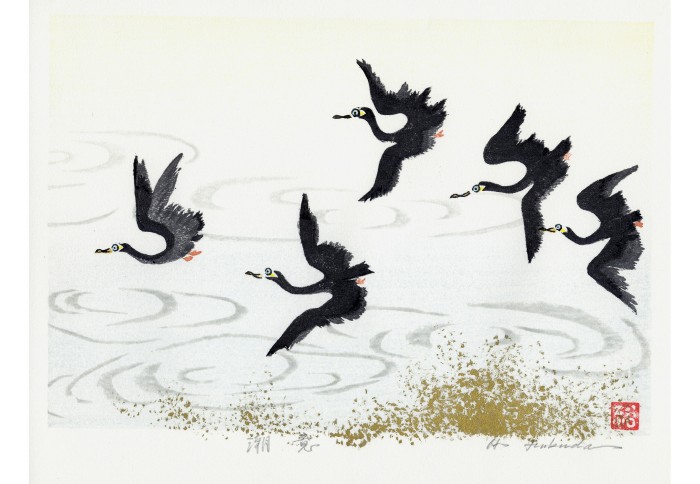
Japanese woodblock printing carries a long, rich history that reached its heights in the Edo period (1603 to 1867). Traditionally the art of creating a woodblock print was broken down into the following specialties*:
- First, an artist would create a design.
- From that drawing, a block copyist would create a very fine black-and-white drawing on paper.
- The print would be passed on to blockcarvers who, using chisels, would carve a series of woodblocks—first, a “key block” showing the outlines of the print, and then one block for each color to be printed – often 15 or more blocks were required.
- When the blocks were complete, printers would apply ink using brushes. Laying a sheet of paper face down on top of the block, the printer rubbed the ink onto [handmade] paper using a round, flat pad, called a “baren”.
Mr. Fukuda applied these very same techniques, with one great exception – all work was designed, hand-carved and, with the help of professionals, hand printed by the artist himself.
Print details:
- Hand-carved and hand printed from 12-15 blocks of wood
- Printed on beautiful hand-made torinokoshi paper
- Individually stamped and signed by the artist
- Limited edition first printing, with only 250 prints made
- 21cm x 19cm (8.2″ x 7.4″)
- Recommended mat border colour: white with a 2-3mm thickness.
Artist profile
Hirokazu Fukuda (1944-2004) was born and raised in the Tochigi prefecture, an area situated a little over an hour north of Tokyo. A picturesque setting, Tochigi is surrounded by mountains and hills to the east, west and north while the Kanto Plains lie to the south. It is also famous for its ancient Shinto shrines and Buddhist temples.
Hirokazu (whose real name is Hiroshi), planned to become a professional classic guitarist but suffered a hand injury at a young age. Hungering after a medium to express his creativity, he first worked with the canvas, then moved on to become a master woodblock artist.
The passing of time never really concerned Mr. Fukuda, a character trait much admired by his peers. His art collection is wonderfully expressive, very true, and seems to bask in the admiration of daily life. According to family and friends, he had always hoped that his work could “touch the heart” of those around him. Mr. Fukuda died peacefully in Tokyo in 2004.
*source: pbs.org
Posted in Uncategorized | No Comments »
Monday, March 29th, 2010
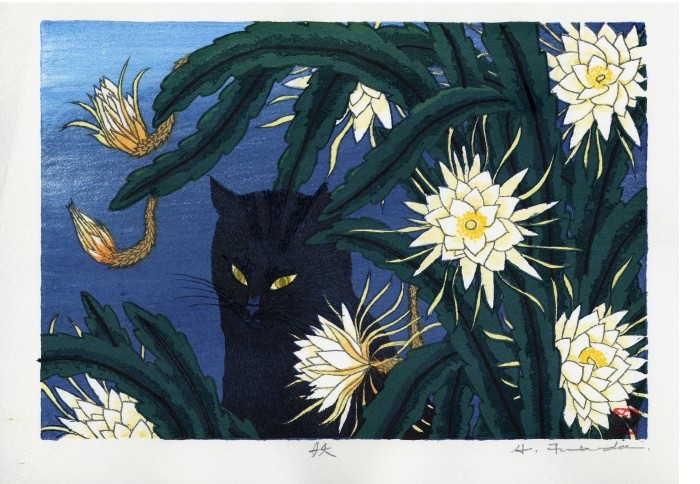
Japanese woodblock printing carries a long, rich history that reached its heights in the Edo period (1603 to 1867). Traditionally the art of creating a woodblock print was broken down into the following specialties*:
- First, an artist would create a design.
- From that drawing, a block copyist would create a very fine black-and-white drawing on paper.
- The print would be passed on to blockcarvers who, using chisels, would carve a series of woodblocks—first, a “key block” showing the outlines of the print, and then one block for each color to be printed – often 15 or more blocks were required.
- When the blocks were complete, printers would apply ink using brushes. Laying a sheet of paper face down on top of the block, the printer rubbed the ink onto [handmade] paper using a round, flat pad, called a “baren”.
Mr. Fukuda applied these very same techniques, with one great exception – all work was designed, hand-carved and, with the help of professionals, hand printed by the artist himself.
Print details:
- Hand-carved and hand printed from 12-15 blocks of wood
- Printed on beautiful hand-made torinokoshi paper
- Individually stamped and signed by the artist
- Limited edition first printing, with only 250 prints made
- 21cm x 19cm (8.2″ x 7.4″)
- Recommended mat border colour: white with a 2-3mm thickness.
Artist profile
Hirokazu Fukuda (1944-2004) was born and raised in the Tochigi prefecture, an area situated a little over an hour north of Tokyo. A picturesque setting, Tochigi is surrounded by mountains and hills to the east, west and north while the Kanto Plains lie to the south. It is also famous for its ancient Shinto shrines and Buddhist temples.
Hirokazu (whose real name is Hiroshi), planned to become a professional classic guitarist but suffered a hand injury at a young age. Hungering after a medium to express his creativity, he first worked with the canvas, then moved on to become a master woodblock artist.
The passing of time never really concerned Mr. Fukuda, a character trait much admired by his peers. His art collection is wonderfully expressive, very true, and seems to bask in the admiration of daily life. According to family and friends, he had always hoped that his work could “touch the heart” of those around him. Mr. Fukuda died peacefully in Tokyo in 2004.
*source: pbs.org
Posted in Uncategorized | No Comments »
Monday, March 29th, 2010
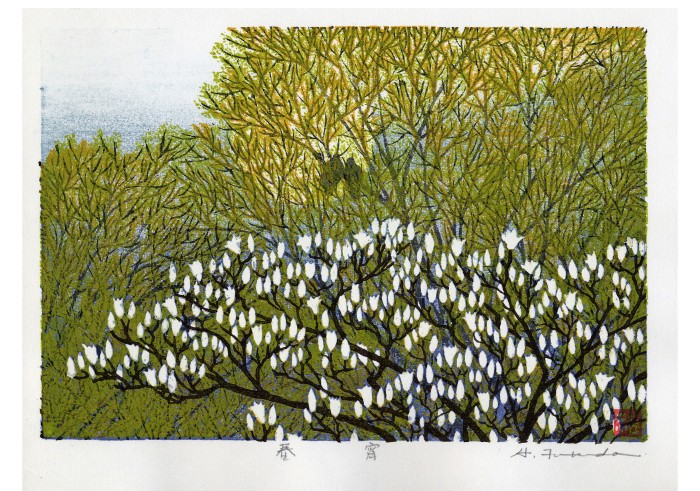
Japanese woodblock printing carries a long, rich history that reached its heights in the Edo period (1603 to 1867). Traditionally the art of creating a woodblock print was broken down into the following specialties*:
- First, an artist would create a design.
- From that drawing, a block copyist would create a very fine black-and-white drawing on paper.
- The print would be passed on to blockcarvers who, using chisels, would carve a series of woodblocks—first, a “key block” showing the outlines of the print, and then one block for each color to be printed – often 15 or more blocks were required.
- When the blocks were complete, printers would apply ink using brushes. Laying a sheet of paper face down on top of the block, the printer rubbed the ink onto [handmade] paper using a round, flat pad, called a “baren”.
Mr. Fukuda applied these very same techniques, with one great exception – all work was designed, hand-carved and, with the help of professionals, hand printed by the artist himself.
Print details:
- Hand-carved and hand printed from 12-15 blocks of wood
- Printed on beautiful hand-made torinokoshi paper
- Individually stamped and signed by the artist
- Limited edition first printing, with only 250 prints made
- 21cm x 19cm (8.2″ x 7.4″)
- Recommended mat border colour: white with a 2-3mm thickness.
Artist profile
Hirokazu Fukuda (1944-2004) was born and raised in the Tochigi prefecture, an area situated a little over an hour north of Tokyo. A picturesque setting, Tochigi is surrounded by mountains and hills to the east, west and north while the Kanto Plains lie to the south. It is also famous for its ancient Shinto shrines and Buddhist temples.
Hirokazu (whose real name is Hiroshi), planned to become a professional classic guitarist but suffered a hand injury at a young age. Hungering after a medium to express his creativity, he first worked with the canvas, then moved on to become a master woodblock artist.
The passing of time never really concerned Mr. Fukuda, a character trait much admired by his peers. His art collection is wonderfully expressive, very true, and seems to bask in the admiration of daily life. According to family and friends, he had always hoped that his work could “touch the heart” of those around him. Mr. Fukuda died peacefully in Tokyo in 2004.
*source: pbs.org
Posted in Uncategorized | No Comments »
Monday, March 29th, 2010
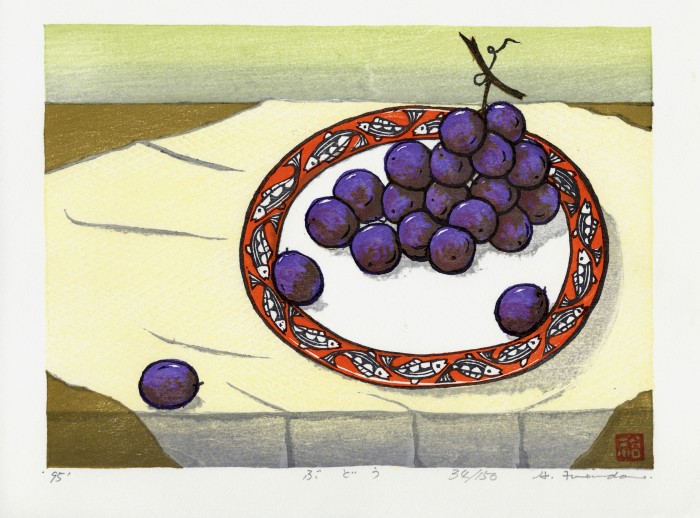
Japanese woodblock printing carries a long, rich history that reached its heights in the Edo period (1603 to 1867). Traditionally the art of creating a woodblock print was broken down into the following specialties*:
- First, an artist would create a design.
- From that drawing, a block copyist would create a very fine black-and-white drawing on paper.
- The print would be passed on to blockcarvers who, using chisels, would carve a series of woodblocks—first, a “key block” showing the outlines of the print, and then one block for each color to be printed – often 15 or more blocks were required.
- When the blocks were complete, printers would apply ink using brushes. Laying a sheet of paper face down on top of the block, the printer rubbed the ink onto [handmade] paper using a round, flat pad, called a “baren”.
Mr. Fukuda applied these very same techniques, with one great exception – all work was designed, hand-carved and, with the help of professionals, hand printed by the artist himself.
Print details:
- Hand-carved and hand printed from 12-15 blocks of wood
- Printed on beautiful hand-made torinokoshi paper
- Individually stamped and signed by the artist
- Limited edition first printing, with only 250 prints made
- 21cm x 19cm (8.2″ x 7.4″)
- Recommended mat border colour: white with a 2-3mm thickness.
Artist profile
Hirokazu Fukuda (1944-2004) was born and raised in the Tochigi prefecture, an area situated a little over an hour north of Tokyo. A picturesque setting, Tochigi is surrounded by mountains and hills to the east, west and north while the Kanto Plains lie to the south. It is also famous for its ancient Shinto shrines and Buddhist temples.
Hirokazu (whose real name is Hiroshi), planned to become a professional classic guitarist but suffered a hand injury at a young age. Hungering after a medium to express his creativity, he first worked with the canvas, then moved on to become a master woodblock artist.
The passing of time never really concerned Mr. Fukuda, a character trait much admired by his peers. His art collection is wonderfully expressive, very true, and seems to bask in the admiration of daily life. According to family and friends, he had always hoped that his work could “touch the heart” of those around him. Mr. Fukuda died peacefully in Tokyo in 2004.
*source: pbs.org
Posted in Uncategorized | No Comments »
Monday, March 29th, 2010
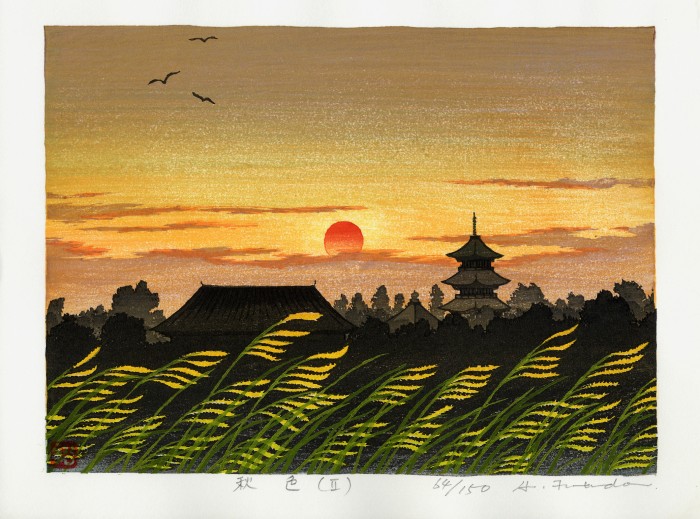
Japanese woodblock printing carries a long, rich history that reached its heights in the Edo period (1603 to 1867). Traditionally the art of creating a woodblock print was broken down into the following specialties*:
- First, an artist would create a design.
- From that drawing, a block copyist would create a very fine black-and-white drawing on paper.
- The print would be passed on to blockcarvers who, using chisels, would carve a series of woodblocks—first, a “key block” showing the outlines of the print, and then one block for each color to be printed – often 15 or more blocks were required.
- When the blocks were complete, printers would apply ink using brushes. Laying a sheet of paper face down on top of the block, the printer rubbed the ink onto [handmade] paper using a round, flat pad, called a “baren”.
Mr. Fukuda applied these very same techniques, with one great exception – all work was designed, hand-carved and, with the help of professionals, hand printed by the artist himself.
Print details:
- Hand-carved and hand printed from 12-15 blocks of wood
- Printed on beautiful hand-made torinokoshi paper
- Individually stamped and signed by the artist
- Limited edition first printing, with only 250 prints made
- 21cm x 19cm (8.2″ x 7.4″)
- Recommended mat border colour: white with a 2-3mm thickness.
Artist profile
Hirokazu Fukuda (1944-2004) was born and raised in the Tochigi prefecture, an area situated a little over an hour north of Tokyo. A picturesque setting, Tochigi is surrounded by mountains and hills to the east, west and north while the Kanto Plains lie to the south. It is also famous for its ancient Shinto shrines and Buddhist temples.
Hirokazu (whose real name is Hiroshi), planned to become a professional classic guitarist but suffered a hand injury at a young age. Hungering after a medium to express his creativity, he first worked with the canvas, then moved on to become a master woodblock artist.
The passing of time never really concerned Mr. Fukuda, a character trait much admired by his peers. His art collection is wonderfully expressive, very true, and seems to bask in the admiration of daily life. According to family and friends, he had always hoped that his work could “touch the heart” of those around him. Mr. Fukuda died peacefully in Tokyo in 2004.
*source: pbs.org
Posted in Uncategorized | No Comments »
Monday, March 29th, 2010
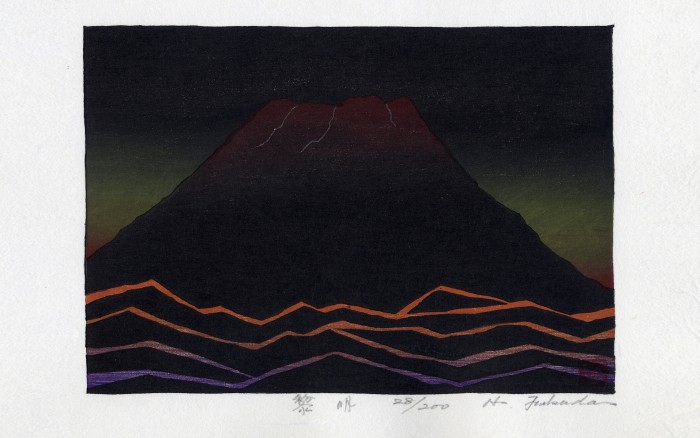
Japanese woodblock printing carries a long, rich history that reached its heights in the Edo period (1603 to 1867). Traditionally the art of creating a woodblock print was broken down into the following specialties*:
- First, an artist would create a design.
- From that drawing, a block copyist would create a very fine black-and-white drawing on paper.
- The print would be passed on to blockcarvers who, using chisels, would carve a series of woodblocks—first, a “key block” showing the outlines of the print, and then one block for each color to be printed – often 15 or more blocks were required.
- When the blocks were complete, printers would apply ink using brushes. Laying a sheet of paper face down on top of the block, the printer rubbed the ink onto [handmade] paper using a round, flat pad, called a “baren”.
Mr. Fukuda applied these very same techniques, with one great exception – all work was designed, hand-carved and, with the help of professionals, hand printed by the artist himself.
Print details:
- Hand-carved and hand printed from 12-15 blocks of wood
- Printed on beautiful hand-made torinokoshi paper
- Individually stamped and signed by the artist
- Limited edition first printing, with only 250 prints made
- 21cm x 19cm (8.2″ x 7.4″)
- Recommended mat border colour: white with a 2-3mm thickness.
Artist profile
Hirokazu Fukuda (1944-2004) was born and raised in the Tochigi prefecture, an area situated a little over an hour north of Tokyo. A picturesque setting, Tochigi is surrounded by mountains and hills to the east, west and north while the Kanto Plains lie to the south. It is also famous for its ancient Shinto shrines and Buddhist temples.
Hirokazu (whose real name is Hiroshi), planned to become a professional classic guitarist but suffered a hand injury at a young age. Hungering after a medium to express his creativity, he first worked with the canvas, then moved on to become a master woodblock artist.
The passing of time never really concerned Mr. Fukuda, a character trait much admired by his peers. His art collection is wonderfully expressive, very true, and seems to bask in the admiration of daily life. According to family and friends, he had always hoped that his work could “touch the heart” of those around him. Mr. Fukuda died peacefully in Tokyo in 2004.
*source: pbs.org
Posted in Uncategorized | No Comments »
Monday, March 29th, 2010
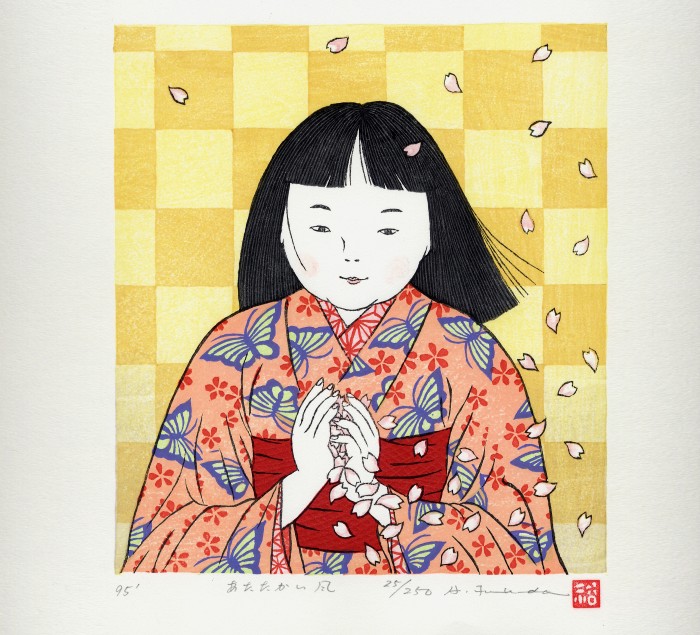
Set your mood to spring with Atatakaikaze (“Warm Wind”), a magnificent woodblock print by the renowned Hirokazu Fukuda (1944-2004). Delicate sakura petals fluttering on a gentle breeze awaken the senses and cheer the soul. Hand-carved and hand-painted, each print is individually stamped and signed by the artist. Limited quantity remaining.Japanese woodblock printing carries a long, rich history that reached its heights in the Edo period (1603 to 1867). Traditionally the art of creating a woodblock print was broken down into the following specialties*:
- First, an artist would create a design.
- From that drawing, a block copyist would create a very fine black-and-white drawing on paper.
- The print would be passed on to blockcarvers who, using chisels, would carve a series of woodblocks—first, a “key block” showing the outlines of the print, and then one block for each color to be printed – often 15 or more blocks were required.
- When the blocks were complete, printers would apply ink using brushes. Laying a sheet of paper face down on top of the block, the printer rubbed the ink onto [handmade] paper using a round, flat pad, called a “baren”.
Mr. Fukuda applied these very same techniques, with one great exception – all work was designed, hand-carved and, with the help of professionals, hand printed by the artist himself.
Print details:
- Hand-carved and hand printed from 12-15 blocks of wood
- Printed on beautiful hand-made torinokoshi paper
- Individually stamped and signed by the artist
- Limited edition first printing, with only 250 prints made
- 21cm x 19cm (8.2″ x 7.4″)
- Recommended mat border colour: white with a 2-3mm thickness.
Artist profile
Hirokazu Fukuda (1944-2004) was born and raised in the Tochigi prefecture, an area situated a little over an hour north of Tokyo. A picturesque setting, Tochigi is surrounded by mountains and hills to the east, west and north while the Kanto Plains lie to the south. It is also famous for its ancient Shinto shrines and Buddhist temples.
Hirokazu (whose real name is Hiroshi), planned to become a professional classic guitarist but suffered a hand injury at a young age. Hungering after a medium to express his creativity, he first worked with the canvas, then moved on to become a master woodblock artist.
The passing of time never really concerned Mr. Fukuda, a character trait much admired by his peers. His art collection is wonderfully expressive, very true, and seems to bask in the admiration of daily life. According to family and friends, he had always hoped that his work could “touch the heart” of those around him. Mr. Fukuda died peacefully in Tokyo in 2004.
*source: pbs.org
Posted in Uncategorized | No Comments »
Monday, March 29th, 2010
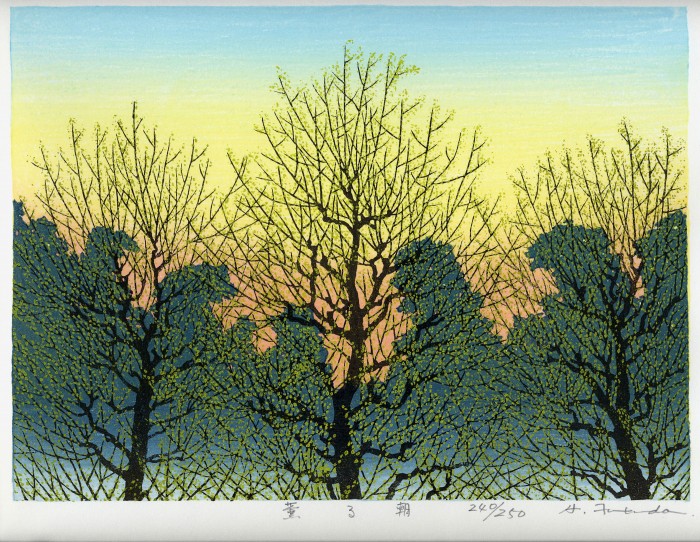
Japanese woodblock printing carries a long, rich history that reached its heights in the Edo period (1603 to 1867). Traditionally the art of creating a woodblock print was broken down into the following specialties*:
- First, an artist would create a design.
- From that drawing, a block copyist would create a very fine black-and-white drawing on paper.
- The print would be passed on to blockcarvers who, using chisels, would carve a series of woodblocks—first, a “key block” showing the outlines of the print, and then one block for each color to be printed – often 15 or more blocks were required.
- When the blocks were complete, printers would apply ink using brushes. Laying a sheet of paper face down on top of the block, the printer rubbed the ink onto [handmade] paper using a round, flat pad, called a “baren”.
Mr. Fukuda applied these very same techniques, with one great exception – all work was designed, hand-carved and, with the help of professionals, hand printed by the artist himself.
Print details:
- Hand-carved and hand printed from 12-15 blocks of wood
- Printed on beautiful hand-made torinokoshi paper
- Individually stamped and signed by the artist
- Limited edition first printing, with only 250 prints made
- 27cm x 20cm (10.6″ x 7.8″)
- Recommended mat border colour: white with a 2-3mm thickness.
Artist profile
Hirokazu Fukuda (1944-2004) was born and raised in the Tochigi prefecture, an area situated a little over an hour north of Tokyo. A picturesque setting, Tochigi is surrounded by mountains and hills to the east, west and north while the Kanto Plains lie to the south. It is also famous for its ancient Shinto shrines and Buddhist temples.
Hirokazu (whose real name is Hiroshi), planned to become a professional classic guitarist but suffered a hand injury at a young age. Hungering after a medium to express his creativity, he first worked with the canvas, then moved on to become a master woodblock artist.
The passing of time never really concerned Mr. Fukuda, a character trait much admired by his peers. His art collection is wonderfully expressive, very true, and seems to bask in the admiration of daily life. According to family and friends, he had always hoped that his work could “touch the heart” of those around him. Mr. Fukuda died peacefully in Tokyo in 2004.
*source: pbs.org
Posted in Uncategorized | No Comments »
Monday, March 29th, 2010
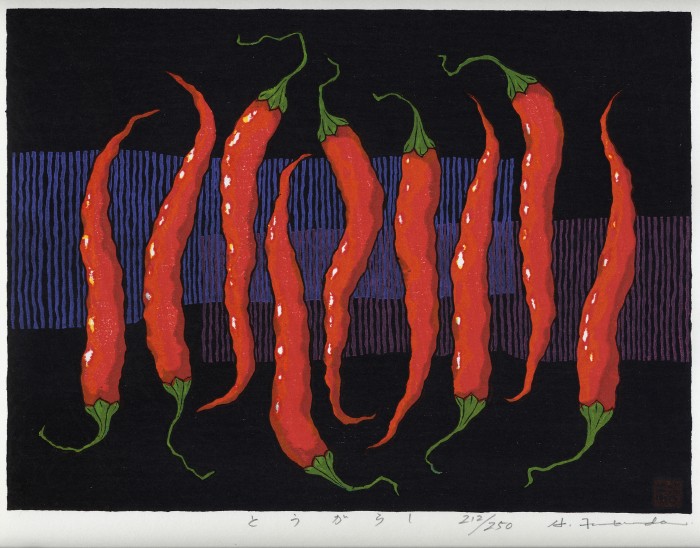
Japanese woodblock printing carries a long, rich history that reached its heights in the Edo period (1603 to 1867). Traditionally the art of creating a woodblock print was broken down into the following specialties*:
- First, an artist would create a design.
- From that drawing, a block copyist would create a very fine black-and-white drawing on paper.
- The print would be passed on to blockcarvers who, using chisels, would carve a series of woodblocks—first, a “key block” showing the outlines of the print, and then one block for each color to be printed – often 15 or more blocks were required.
- When the blocks were complete, printers would apply ink using brushes. Laying a sheet of paper face down on top of the block, the printer rubbed the ink onto [handmade] paper using a round, flat pad, called a “baren”.
Mr. Fukuda applied these very same techniques, with one great exception – all work was designed, hand-carved and, with the help of professionals, hand printed by the artist himself.
Print details:
- Hand-carved and hand printed from 12-15 blocks of wood
- Printed on beautiful hand-made torinokoshi paper
- Individually stamped and signed by the artist
- Limited edition first printing, with only 250 prints made
- 27cm x 20cm (10.6″ x 7.8″)
- Recommended mat border colour: white with a 2-3mm thickness.
Artist profile
Hirokazu Fukuda (1944-2004) was born and raised in the Tochigi prefecture, an area situated a little over an hour north of Tokyo. A picturesque setting, Tochigi is surrounded by mountains and hills to the east, west and north while the Kanto Plains lie to the south. It is also famous for its ancient Shinto shrines and Buddhist temples.
Hirokazu (whose real name is Hiroshi), planned to become a professional classic guitarist but suffered a hand injury at a young age. Hungering after a medium to express his creativity, he first worked with the canvas, then moved on to become a master woodblock artist.
The passing of time never really concerned Mr. Fukuda, a character trait much admired by his peers. His art collection is wonderfully expressive, very true, and seems to bask in the admiration of daily life. According to family and friends, he had always hoped that his work could “touch the heart” of those around him. Mr. Fukuda died peacefully in Tokyo in 2004.
*source: pbs.org
Posted in Uncategorized | No Comments »
Monday, March 29th, 2010
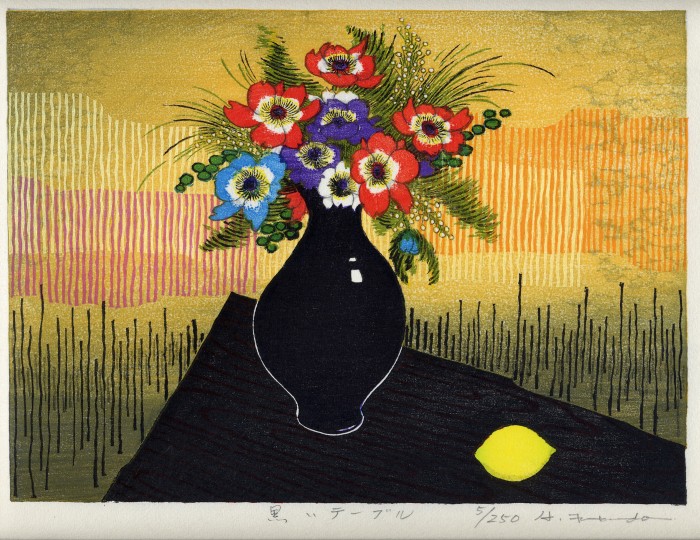
Japanese woodblock printing carries a long, rich history that reached its heights in the Edo period (1603 to 1867). Traditionally the art of creating a woodblock print was broken down into the following specialties*:
- First, an artist would create a design.
- From that drawing, a block copyist would create a very fine black-and-white drawing on paper.
- The print would be passed on to blockcarvers who, using chisels, would carve a series of woodblocks—first, a “key block” showing the outlines of the print, and then one block for each color to be printed – often 15 or more blocks were required.
- When the blocks were complete, printers would apply ink using brushes. Laying a sheet of paper face down on top of the block, the printer rubbed the ink onto [handmade] paper using a round, flat pad, called a “baren”.
Mr. Fukuda applied these very same techniques, with one great exception – all work was designed, hand-carved and, with the help of professionals, hand printed by the artist himself.
Print details:
- Hand-carved and hand printed from 12-15 blocks of wood
- Printed on beautiful hand-made torinokoshi paper
- Individually stamped and signed by the artist
- Limited edition first printing, with only 250 prints made
- 27cm x 20cm (10.6″ x 7.8″)
- Recommended mat border colour: white with a 2-3mm thickness.
Artist profile
Hirokazu Fukuda (1944-2004) was born and raised in the Tochigi prefecture, an area situated a little over an hour north of Tokyo. A picturesque setting, Tochigi is surrounded by mountains and hills to the east, west and north while the Kanto Plains lie to the south. It is also famous for its ancient Shinto shrines and Buddhist temples.
Hirokazu (whose real name is Hiroshi), planned to become a professional classic guitarist but suffered a hand injury at a young age. Hungering after a medium to express his creativity, he first worked with the canvas, then moved on to become a master woodblock artist.
The passing of time never really concerned Mr. Fukuda, a character trait much admired by his peers. His art collection is wonderfully expressive, very true, and seems to bask in the admiration of daily life. According to family and friends, he had always hoped that his work could “touch the heart” of those around him. Mr. Fukuda died peacefully in Tokyo in 2004.
*source: pbs.org
Posted in Uncategorized | No Comments »
Monday, March 29th, 2010
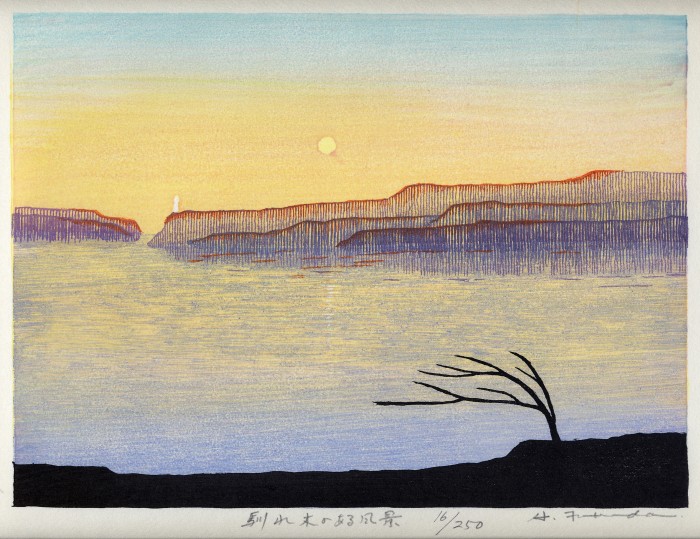
Japanese woodblock printing carries a long, rich history that reached its heights in the Edo period (1603 to 1867). Traditionally the art of creating a woodblock print was broken down into the following specialties*:
- First, an artist would create a design.
- From that drawing, a block copyist would create a very fine black-and-white drawing on paper.
- The print would be passed on to blockcarvers who, using chisels, would carve a series of woodblocks—first, a “key block” showing the outlines of the print, and then one block for each color to be printed – often 15 or more blocks were required.
- When the blocks were complete, printers would apply ink using brushes. Laying a sheet of paper face down on top of the block, the printer rubbed the ink onto [handmade] paper using a round, flat pad, called a “baren”.
Mr. Fukuda applied these very same techniques, with one great exception – all work was designed, hand-carved and, with the help of professionals, hand printed by the artist himself.
Print details:
- Hand-carved and hand printed from 12-15 blocks of wood
- Printed on beautiful hand-made torinokoshi paper
- Individually stamped and signed by the artist
- Limited edition first printing, with only 250 prints made
- 27cm x 20cm (10.6″ x 7.8″)
- Recommended mat border colour: white with a 2-3mm thickness.
Artist profile
Hirokazu Fukuda (1944-2004) was born and raised in the Tochigi prefecture, an area situated a little over an hour north of Tokyo. A picturesque setting, Tochigi is surrounded by mountains and hills to the east, west and north while the Kanto Plains lie to the south. It is also famous for its ancient Shinto shrines and Buddhist temples.
Hirokazu (whose real name is Hiroshi), planned to become a professional classic guitarist but suffered a hand injury at a young age. Hungering after a medium to express his creativity, he first worked with the canvas, then moved on to become a master woodblock artist.
The passing of time never really concerned Mr. Fukuda, a character trait much admired by his peers. His art collection is wonderfully expressive, very true, and seems to bask in the admiration of daily life. According to family and friends, he had always hoped that his work could “touch the heart” of those around him. Mr. Fukuda died peacefully in Tokyo in 2004.
*source: pbs.org
Posted in Uncategorized | No Comments »
Monday, March 29th, 2010
Japanese woodblock printing carries a long, rich history that reached its heights in the Edo period (1603 to 1867). Traditionally the art of creating a woodblock print was broken down into the following specialties*:
- First, an artist would create a design.
- From that drawing, a block copyist would create a very fine black-and-white drawing on paper.
- The print would be passed on to blockcarvers who, using chisels, would carve a series of woodblocks—first, a “key block” showing the outlines of the print, and then one block for each color to be printed – often 15 or more blocks were required.
- When the blocks were complete, printers would apply ink using brushes. Laying a sheet of paper face down on top of the block, the printer rubbed the ink onto [handmade] paper using a round, flat pad, called a “baren”.
Mr. Fukuda applied these very same techniques, with one great exception – all work was designed, hand-carved and, with the help of professionals, hand printed by the artist himself.
Print details:
- Hand-carved and hand printed from 12-15 blocks of wood
- Printed on beautiful hand-made torinokoshi paper
- Individually stamped and signed by the artist
- Limited edition first printing, with only 250 prints made
- 27cm x 20cm (10.6″ x 7.8″)
- Recommended mat border colour: white with a 2-3mm thickness.
Artist profile
Hirokazu Fukuda (1944-2004) was born and raised in the Tochigi prefecture, an area situated a little over an hour north of Tokyo. A picturesque setting, Tochigi is surrounded by mountains and hills to the east, west and north while the Kanto Plains lie to the south. It is also famous for its ancient Shinto shrines and Buddhist temples.
Hirokazu (whose real name is Hiroshi), planned to become a professional classic guitarist but suffered a hand injury at a young age. Hungering after a medium to express his creativity, he first worked with the canvas, then moved on to become a master woodblock artist.
The passing of time never really concerned Mr. Fukuda, a character trait much admired by his peers. His art collection is wonderfully expressive, very true, and seems to bask in the admiration of daily life. According to family and friends, he had always hoped that his work could “touch the heart” of those around him. Mr. Fukuda died peacefully in Tokyo in 2004.
*source: pbs.org
Posted in Uncategorized | No Comments »
Monday, March 29th, 2010
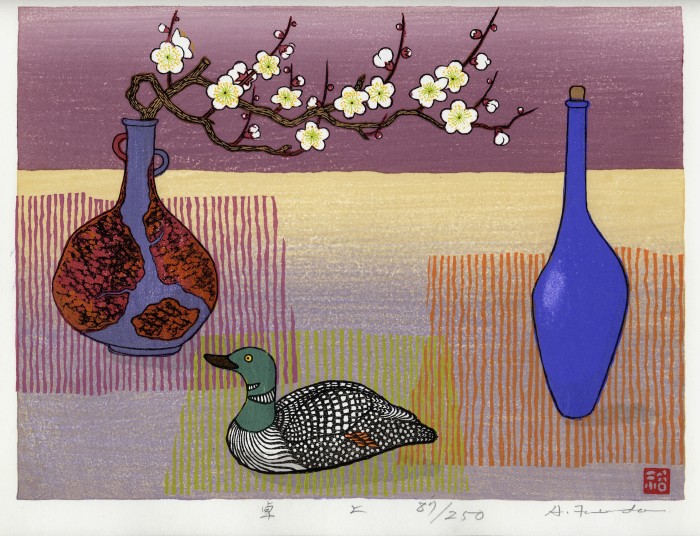
Japanese woodblock printing carries a long, rich history that reached its heights in the Edo period (1603 to 1867). Traditionally the art of creating a woodblock print was broken down into the following specialties*:
- First, an artist would create a design.
- From that drawing, a block copyist would create a very fine black-and-white drawing on paper.
- The print would be passed on to blockcarvers who, using chisels, would carve a series of woodblocks—first, a “key block” showing the outlines of the print, and then one block for each color to be printed – often 15 or more blocks were required.
- When the blocks were complete, printers would apply ink using brushes. Laying a sheet of paper face down on top of the block, the printer rubbed the ink onto [handmade] paper using a round, flat pad, called a “baren”.
Mr. Fukuda applied these very same techniques, with one great exception – all work was designed, hand-carved and, with the help of professionals, hand printed by the artist himself.
Print details:
- Hand-carved and hand printed from 12-15 blocks of wood
- Printed on beautiful hand-made torinokoshi paper
- Individually stamped and signed by the artist
- Limited edition first printing, with only 250 prints made
- 27cm x 20cm (10.6″ x 7.8″)
- Recommended mat border colour: white with a 2-3mm thickness.
Artist profile
Hirokazu Fukuda (1944-2004) was born and raised in the Tochigi prefecture, an area situated a little over an hour north of Tokyo. A picturesque setting, Tochigi is surrounded by mountains and hills to the east, west and north while the Kanto Plains lie to the south. It is also famous for its ancient Shinto shrines and Buddhist temples.
Hirokazu (whose real name is Hiroshi), planned to become a professional classic guitarist but suffered a hand injury at a young age. Hungering after a medium to express his creativity, he first worked with the canvas, then moved on to become a master woodblock artist.
The passing of time never really concerned Mr. Fukuda, a character trait much admired by his peers. His art collection is wonderfully expressive, very true, and seems to bask in the admiration of daily life. According to family and friends, he had always hoped that his work could “touch the heart” of those around him. Mr. Fukuda died peacefully in Tokyo in 2004.
*source: pbs.org
Posted in Uncategorized | No Comments »
Monday, March 29th, 2010
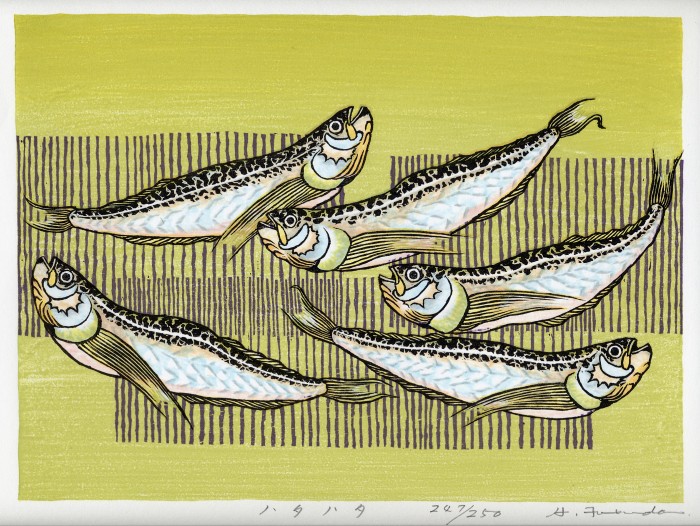
Japanese woodblock printing carries a long, rich history that reached its heights in the Edo period (1603 to 1867). Traditionally the art of creating a woodblock print was broken down into the following specialties*:
- First, an artist would create a design.
- From that drawing, a block copyist would create a very fine black-and-white drawing on paper.
- The print would be passed on to blockcarvers who, using chisels, would carve a series of woodblocks—first, a “key block” showing the outlines of the print, and then one block for each color to be printed – often 15 or more blocks were required.
- When the blocks were complete, printers would apply ink using brushes. Laying a sheet of paper face down on top of the block, the printer rubbed the ink onto [handmade] paper using a round, flat pad, called a “baren”.
Mr. Fukuda applied these very same techniques, with one great exception – all work was designed, hand-carved and, with the help of professionals, hand printed by the artist himself.
Print details:
- Hand-carved and hand printed from 12-15 blocks of wood
- Printed on beautiful hand-made torinokoshi paper
- Individually stamped and signed by the artist
- Limited edition first printing, with only 250 prints made
- 27cm x 20cm (10.6″ x 7.8″)
- Recommended mat border colour: white with a 2-3mm thickness.
Artist profile
Hirokazu Fukuda (1944-2004) was born and raised in the Tochigi prefecture, an area situated a little over an hour north of Tokyo. A picturesque setting, Tochigi is surrounded by mountains and hills to the east, west and north while the Kanto Plains lie to the south. It is also famous for its ancient Shinto shrines and Buddhist temples.
Hirokazu (whose real name is Hiroshi), planned to become a professional classic guitarist but suffered a hand injury at a young age. Hungering after a medium to express his creativity, he first worked with the canvas, then moved on to become a master woodblock artist.
The passing of time never really concerned Mr. Fukuda, a character trait much admired by his peers. His art collection is wonderfully expressive, very true, and seems to bask in the admiration of daily life. According to family and friends, he had always hoped that his work could “touch the heart” of those around him. Mr. Fukuda died peacefully in Tokyo in 2004.
*source: pbs.org
Posted in Uncategorized | No Comments »
Monday, March 29th, 2010
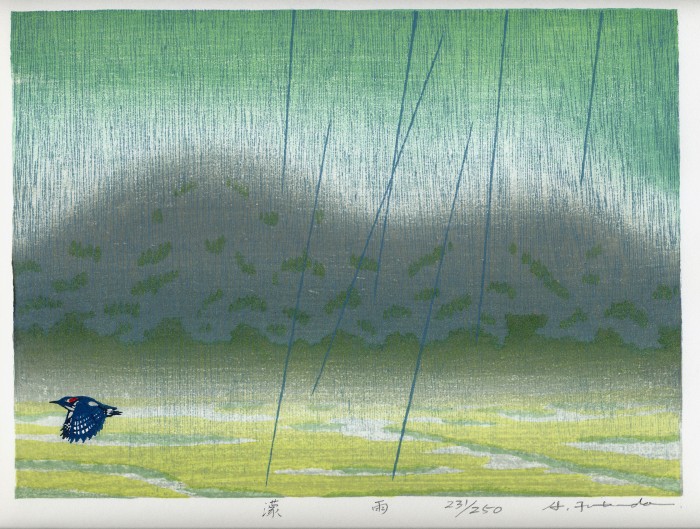
Japanese woodblock printing carries a long, rich history that reached its heights in the Edo period (1603 to 1867). Traditionally the art of creating a woodblock print was broken down into the following specialties*:
- First, an artist would create a design.
- From that drawing, a block copyist would create a very fine black-and-white drawing on paper.
- The print would be passed on to blockcarvers who, using chisels, would carve a series of woodblocks—first, a “key block” showing the outlines of the print, and then one block for each color to be printed – often 15 or more blocks were required.
- When the blocks were complete, printers would apply ink using brushes. Laying a sheet of paper face down on top of the block, the printer rubbed the ink onto [handmade] paper using a round, flat pad, called a “baren”.
Mr. Fukuda applied these very same techniques, with one great exception – all work was designed, hand-carved and, with the help of professionals, hand printed by the artist himself.
Print details:
- Hand-carved and hand printed from 12-15 blocks of wood
- Printed on beautiful hand-made torinokoshi paper
- Individually stamped and signed by the artist
- Limited edition first printing, with only 250 prints made
- 27cm x 20cm (10.6″ x 7.8″)
- Recommended mat border colour: white with a 2-3mm thickness.
Artist profile
Hirokazu Fukuda (1944-2004) was born and raised in the Tochigi prefecture, an area situated a little over an hour north of Tokyo. A picturesque setting, Tochigi is surrounded by mountains and hills to the east, west and north while the Kanto Plains lie to the south. It is also famous for its ancient Shinto shrines and Buddhist temples.
Hirokazu (whose real name is Hiroshi), planned to become a professional classic guitarist but suffered a hand injury at a young age. Hungering after a medium to express his creativity, he first worked with the canvas, then moved on to become a master woodblock artist.
The passing of time never really concerned Mr. Fukuda, a character trait much admired by his peers. His art collection is wonderfully expressive, very true, and seems to bask in the admiration of daily life. According to family and friends, he had always hoped that his work could “touch the heart” of those around him. Mr. Fukuda died peacefully in Tokyo in 2004.
*source: pbs.org
Posted in Uncategorized | No Comments »
Monday, March 29th, 2010
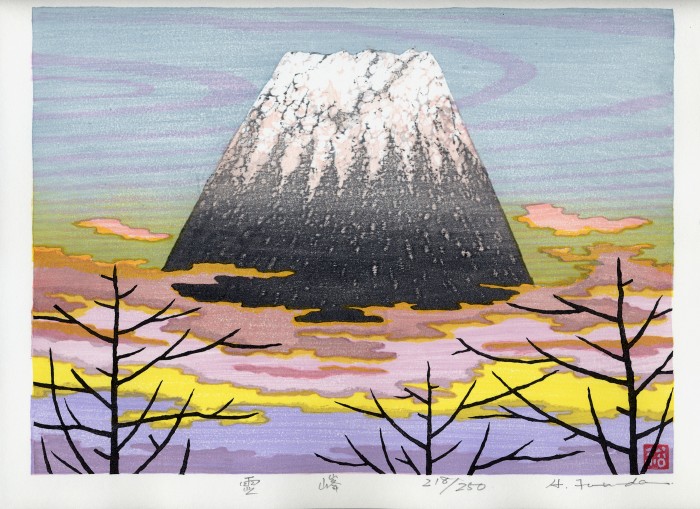
Print notes: Mount Fuji is the tallest and most spectacular mountain in all of Japan. It is a sacred and peaceful cultural symbol greatly admired for its perfect volcanic cone shape, which many equate to an inverted fan.
Japanese woodblock printing carries a long, rich history that reached its heights in the Edo period (1603 to 1867). Traditionally the art of creating a woodblock print was broken down into the following specialties*:
- First, an artist would create a design.
- From that drawing, a block copyist would create a very fine black-and-white drawing on paper.
- The print would be passed on to blockcarvers who, using chisels, would carve a series of woodblocks—first, a “key block” showing the outlines of the print, and then one block for each color to be printed – often 15 or more blocks were required.
- When the blocks were complete, printers would apply ink using brushes. Laying a sheet of paper face down on top of the block, the printer rubbed the ink onto [handmade] paper using a round, flat pad, called a “baren”.
Mr. Fukuda applied these very same techniques, with one great exception – all work was designed, hand-carved and, with the help of professionals, hand printed by the artist himself.
Print details:
- Hand-carved and hand printed from 12-15 blocks of wood
- Printed on beautiful hand-made torinokoshi paper
- Individually stamped and signed by the artist
- Limited edition first printing, with only 250 prints made
- 27cm x 20cm (10.6″ x 7.8″)
- Recommended mat border colour: white with a 2-3mm thickness.
Artist profile
Hirokazu Fukuda (1944-2004) was born and raised in the Tochigi prefecture, an area situated a little over an hour north of Tokyo. A picturesque setting, Tochigi is surrounded by mountains and hills to the east, west and north while the Kanto Plains lie to the south. It is also famous for its ancient Shinto shrines and Buddhist temples.
Hirokazu (whose real name is Hiroshi), planned to become a professional classic guitarist but suffered a hand injury at a young age. Hungering after a medium to express his creativity, he first worked with the canvas, then moved on to become a master woodblock artist.
The passing of time never really concerned Mr. Fukuda, a character trait much admired by his peers. His art collection is wonderfully expressive, very true, and seems to bask in the admiration of daily life. According to family and friends, he had always hoped that his work could “touch the heart” of those around him. Mr. Fukuda died peacefully in Tokyo in 2004.
*source: pbs.org
Posted in Uncategorized | No Comments »
Monday, March 29th, 2010
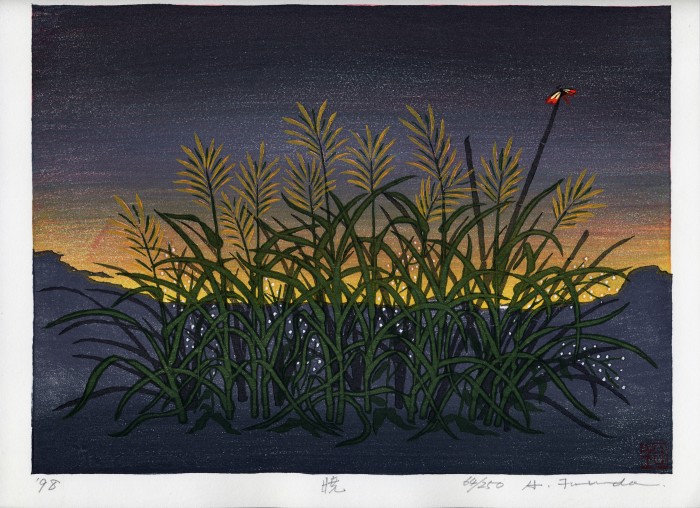
Print notes:
AKA means “red” in Japanese, TSUKI means “moon”. Together they form the meaning of “dawn”. A little red butterfly accents the print in a refined manner.
Japanese woodblock printing carries a long, rich history that reached its heights in the Edo period (1603 to 1867). Traditionally the art of creating a woodblock print was broken down into the following specialties*:
- First, an artist would create a design.
- From that drawing, a block copyist would create a very fine black-and-white drawing on paper.
- The print would be passed on to blockcarvers who, using chisels, would carve a series of woodblocks—first, a “key block” showing the outlines of the print, and then one block for each color to be printed – often 15 or more blocks were required.
- When the blocks were complete, printers would apply ink using brushes. Laying a sheet of paper face down on top of the block, the printer rubbed the ink onto [handmade] paper using a round, flat pad, called a “baren”.
Mr. Fukuda applied these very same techniques, with one great exception – all work was designed, hand-carved and, with the help of professionals, hand printed by the artist himself.
Print details:
- Hand-carved and hand printed from 12-15 blocks of wood
- Printed on beautiful hand-made torinokoshi paper
- Individually stamped and signed by the artist
- Limited edition first printing, with only 250 prints made
- 27cm x 20cm (10.6″ x 7.8″)
- Recommended mat border colour: white with a 2-3mm thickness.
Artist profile
Hirokazu Fukuda (1944-2004) was born and raised in the Tochigi prefecture, an area situated a little over an hour north of Tokyo. A picturesque setting, Tochigi is surrounded by mountains and hills to the east, west and north while the Kanto Plains lie to the south. It is also famous for its ancient Shinto shrines and Buddhist temples.
Hirokazu (whose real name is Hiroshi), planned to become a professional classic guitarist but suffered a hand injury at a young age. Hungering after a medium to express his creativity, he first worked with the canvas, then moved on to become a master woodblock artist.
The passing of time never really concerned Mr. Fukuda, a character trait much admired by his peers. His art collection is wonderfully expressive, very true, and seems to bask in the admiration of daily life. According to family and friends, he had always hoped that his work could “touch the heart” of those around him. Mr. Fukuda died peacefully in Tokyo in 2004.
*source: pbs.org
Posted in Uncategorized | No Comments »










